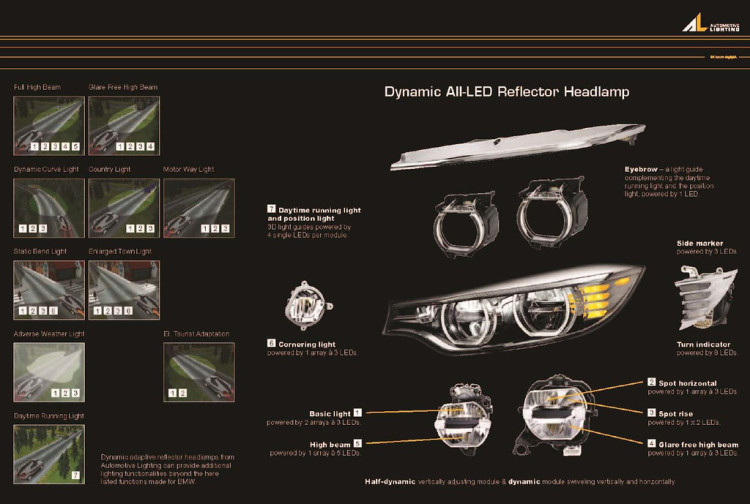New BMW M3/M4 and 4 Series LED headlights explained
Automotive Lighting, the company responsible for the headlights seen on the new F80/F82 M3/M4 and the new 4 Series, are giving united states full picture which depicts the LED technology.
Hussein Al-Attar, the designer responsible for the 4 Series Coupe headlights, described to us in the by the blueprint idea behind the good looking lights.
The BMW iv Series Coupe concept uses basically the aforementioned LED lighting technology found on the six Series lineup, simply moves from rounded lines to an open hexagon. Al-Attar notes that connecting the light-emitting element to the grille — which is completely airtight, by the way — is a new touch on. It looks improve in person than the LEDs on the current 3 Series sedan and is likely to be retained for the production BMW 4 Series coupe.

"We had a very articulate motion picture in mind from the beginning," Al-Attar says well-nigh designing the 4 Serial Coupe concept's lights. "At the end it was really fine-tuning and talking about where to put the line" connecting the lights to the grille, a few millimeters college or lower.
Merely what almost the actual tech backside the lights?
LED in headlamps
In rear lamps, applications with blood-red and xanthous LEDs already are state of the art in lighting technology. In headlamps, especially white LEDs are necessary that for main functions must provide a improve light operation. White LEDs have already been used for signal functions similar position or daytime running light in some serial projects. With the evolution of the first Full-LED headlamp for Audi R8, Automotive Lighting set upwards a world premiere. For the first time, all light functions of a serial headlamp are being realized in LED technology, these are low and high beam, daytime running light, plough indicator and position light.
LED applied science offers new opportunities for the time to come concerning styling, technology and energy consumption.
Advantages of LEDs
LEDs especially stand up out for the following characteristics:
– the light temperature of the LEDs nearly accomplish daylight quality
– an extremely high lifetime lasting more than a whole vehicle life
– a significantly lower energy consumption
– more than constructive opportunities for the use of installation space in headlamps
– unique freedom and variety in styling for the evolution of make characteristic styling elements within headlamps
Function of LEDs
LEDs are based on semiconductor engineering science. The light is emitted directly out of the semiconductor substrate when a forward voltage is applied. The colour depends on the band-gap energy of valence and conduction band for the materials forming the semiconductor. The amber colour is directly generated past the LED by Aluminium Indium Gallium Phosphide (AlInGaP) semiconductor material. Through the luminescence conversion procedure, white light is generated. A blue diode in combination with an applied converter material, the colour blue and xanthous, the combination of which is perceived as white lite.
echnical implementation in headlamps
To accomplish the targeted calorie-free patterns with LED applications in headlamps, two conventional opportunities are available that are already implemented in filament and also in gas belch lamps. Either the low-cal of the LED is redirected through a reflector in club to attain the calorie-free blueprint on the route. Or, alternatively compact systems tin can be applied that project the light in the street using a lens.
Due to their minor sizes, LEDs offer the opportunity to combine both light systems for the beginning time.
Detailed information concerning light technology within the Audi R8 Full-LED headlamp can be found here. (at the moment only available in German)
Temperature management
In dissimilarity to Halogen or Xenon systems, LEDs emit "cold" lite significant that no infrared radiation is being produced. Due to the high efficiency, xx% of the input free energy are transformed into visible light (for comparison a filament bulb just transforms 5%) – the rest of the energy generates heat within the semiconductor chip. Luminous flux, color and frontwards voltage are dependant on the temperature. As soon as the immune temperature is exceeded, the lifetime of the LED volition be badly affected or in worst case will be destroyed.
To protect the hottest part, the chip, cooling elements with a controlled air transportation system have been developed. The systematic management of the warm air to the bezel of the headlamp is so simultaneously existence used for de-icing and decondensation.
Reduction of free energy consumption
The application of LED engineering significantly contributes to the abstention of CO2 emission and the reduction of fuel consumption.
This aspect particularly gains importance with the implementation of daytime running light (DRL). DRL with LED needs 14W of free energy, whereas the apply of conventional vehicle lighting at solar day (depression beam, rear lights, position lights) consumes 300W.
[Source: AL-Lighting via f80post]
schardtaceeakell1955.blogspot.com
Source: https://www.bmwblog.com/2014/02/10/new-bmw-m3m4-4-series-led-headlights-explained/
0 Response to "New BMW M3/M4 and 4 Series LED headlights explained"
Post a Comment